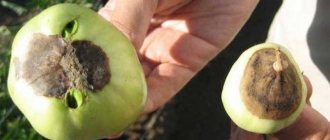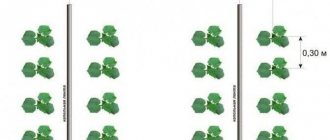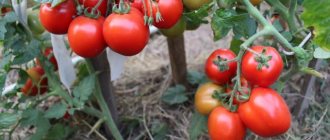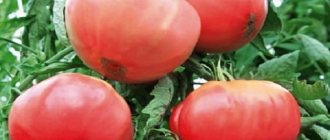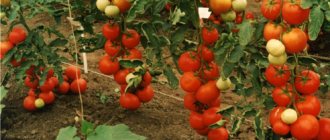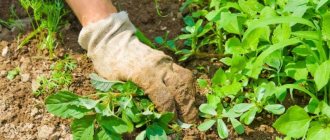Prevention measures
Tomato Bagheera has good resistance to most common diseases.
This does not mean that preventative methods can be neglected. Before planting seeds or seedlings, the soil is treated with a manganese solution: this allows you to kill all harmful substances. At first, the seedlings are sprayed with antifungal drugs. To reduce the likelihood of root rot, it is important to adjust the irrigation system, remember to loosen the soil and remove all weeds. A mulching system consisting of using straw with humus or peat compounds will also help against rot.
Tomato BAGIRA, description, growing experience
TOMATOES BAGIRA
TOMATOES BAGIRA
In the fight against parasites, a manganese solution comes to the rescue. They should spray all the bushes. If slugs or Colorado potato beetles begin to appear, they are removed from the plants independently. As a preventive measure against such neighbors, they use “Regent” or “Araks”.
Description of the variety
Bagheera has a high yield. Up to 9-10 kilograms of tomatoes are harvested from one square meter. Plants grow quickly, but have a small height of up to 1.6 meters. There are a small number of green leaves on the stem. They don't interfere with the tomato's singing.
The fruits are characterized by sweetness and juiciness. The weight of an average tomato reaches 200 grams. Its skin is thin, but elastic. A ripe tomato is bright red.
Bagheera is grown everywhere: both in greenhouses and greenhouses, and on the street. The variety is not afraid of frost and persists when the temperature drops. However, preference should be given to greenhouse cultivation, as the taste of tomatoes will be more intense than that of street tomatoes.
The plant is formed into one or two stems. Pruning is carried out as it is formed throughout the entire growing period.
Description, benefits and reviews
Hybrid Bagheera F1 belongs to the early varieties. The first fruits ripen 65 days after planting. The shape of the fruit is round, with a barely noticeable nose, the surface is smooth. The color is red, rich, uniform outside and inside the fruit. There is no green spot near the stalk. User reviews claim that the tomatoes inside are fleshy, juicy, multi-chambered, and tasty. The fruits do not ripen at the same time; fruiting is extended.
The weight of one tomato is approximately 200 g.
Determinate hybrid. The bush is powerful, up to 1 m high, with a large number of shoots and leaves. The variety bears fruit equally well in different climatic conditions and is not afraid of temperature drops in the spring. The yield when using drip irrigation and good care reaches 100 tons per hectare.
Hybrid Bagheera F1 has good keeping quality. Gardeners who grew the Bagheera tomato claim that its fruits are well stored and can last up to a month without losing their marketable qualities. The dense consistency of the tomato makes it possible to transport it over long distances. You can use it in salads, salt it, and preserve it for the winter. Smaller fruits are processed into tomatoes.
Hardy, beautiful, productive variety for your beds - Bagheera tomato
Early high-yielding hybrids are a real boon for the garden. They are cold-resistant, do not need pinching, and practically do not get sick.
A striking example is the Bagheera tomato variety, characterized by good yield and excellent taste of ripe fruits.
- Tomato Bagheera f1 variety description
- Origin and application
- Advantages and disadvantages
- Photo
- Tomatoes Bagheera characteristics and cultivation features
- Diseases and pests: prevention and control methods
- Useful video
Tomato Bagheera F1 is an early-ripening, high-yielding hybrid of the first generation. The bush is determinate, compact, with moderate formation of green mass.
The leaves are simple, medium-sized, dark green. Tomatoes ripen in clusters of 4-6 pieces. Productivity is high, from 1 sq. m of plantings, you can collect up to 10 kg of selected tomatoes.
The fruits are medium-sized, weighing from 80 to 250 g. On the lower branches, the tomatoes are larger. The tomatoes are smooth, flat-rounded, with pronounced ribbing at the stalk.
The color of ripe fruits is deep red, uniform, without spots or stripes. The pulp is moderately juicy, dense, fleshy. There are at least 6 seed chambers. The sugar content is 2.1%, dry matter in the juice is 5%. The taste of ripe Bagheera tomatoes is pleasant, sweetish, not watery.
Origin and application
The Bagheera variety was bred by Russian breeders and zoned for areas with a temperate climate. It is recommended to grow in open beds and under film; in regions with cold climates, planting in a greenhouse is possible.
Thanks to the thick walls and thin but dense skin, the collected tomatoes are well stored and can be transported for a long time. Bagheera tomatoes, picked at the technical ripeness stage, ripen successfully at room temperature.
The fruits are universally used; they can be eaten fresh and used for making salads, soups, sauces, purees, and juices. Tomatoes are suitable for whole-fruit canning.
Among the main advantages of the variety:
- early maturation;
- high taste qualities of fruits;
- compact bushes save space in the garden;
- drought resistance, cold resistance;
- resistance to major diseases.
See below: tomato Bagheera f1 photo
Tomatoes Bagheera characteristics and cultivation features
Bagheera variety tomatoes are more convenient to grow in seedlings. The seeds do not require special treatment; they undergo all necessary procedures before sale.
For seedlings, a light substrate is prepared - a mixture of garden soil with humus or peat. The seeds are sown in a container with a depth of 1.5-2 cm. The plantings are sprayed with water and placed in a warm place until seedlings emerge.
Young plants are exposed to bright light. When the first pair of true leaves appears, the seedlings are planted and then fed with liquid complex fertilizer.
Before planting in the ground, tomatoes are hardened off by placing them in fresh air, first for several hours, and then for the whole day.
Transplanting to the beds begins in late May or early June. In the first days, young plants can be covered with film. The distance between the bushes is 40-50 cm, no support is required. Tomatoes need to be watered abundantly, but infrequently, with warm, settled water. Every 2 weeks the bushes are fed with a complete complex fertilizer.
Diseases and pests: prevention and control methods
The Bagheera tomato variety is resistant to fusarium, verticillium and other typical nightshade diseases. However, it is impossible to do without preventive measures. Before planting, it is recommended to disinfect the soil with a hot solution of potassium permanganate.
Young plants are regularly sprayed with phytosporin or another non-toxic drug with an antifungal effect.
Proper watering, frequent loosening of the soil, and mulching with peat or humus will help prevent the appearance of root rot.
Bagheera f1 tomatoes are not affected by nematodes, but they can be threatened by other pests: aphids, whiteflies, thrips. For prevention, you can spray the plantings with a pale pink solution of potassium permanganate.
In case of severe damage, industrial insecticides will help, but they can only be used before fruiting begins. Naked slugs, mole cricket larvae and Colorado potato beetles, which often infect plants in open ground, are collected by hand.
It is recommended to spray the bushes with a weak solution of ammonia.
Bagheera variety tomatoes are suitable for beginners and experienced gardeners. They are easy to care for, easily tolerate errors in agricultural technology, guaranteeing excellent fruit taste and a good harvest.
Characteristics and description of the Bagira tomato variety, its yield
Tomato Bagheera F1 is characterized by resistance to cold weather, so the variety bears fruit remarkably well in cool areas. The tomatoes were bred by Russian breeders. For this F1 hybrid, the description marks the variety as tomatoes with record early ripening. The first fruits can be obtained already on the 65th day from the beginning of seed germination. The plant is not susceptible to diseases such as late blight.
general information
Bagheera tomatoes are characterized by short stature and compactness, which does not prevent them from producing a rich harvest. The characteristics and description of the variety are wonderfully formulated by Russian breeders. In one season you can grow up to 100 fruits on one bush.
The plant itself is well leafy and does not require pinching. The tomato leaves are dark green, medium in size, and the inflorescences are simple.
Experienced gardeners, in order to obtain an early harvest, remove the stepsons before the first inflorescences. But in the future, this leads to a smaller harvest, since the lion’s share of the fruit is formed on these stepsons. It is worth making a choice between the speed of tomato ripening and the amount of harvest obtained.
The fruits are characterized by wonderful taste. Ripe tomatoes have a bright red, attractive color and smell wonderful. The average weight of the fruit, as stated in the characteristics and description of the variety, is 200 g. On the lower branches the fruit is larger than on the upper ones.
Tomatoes have a round and even shape, with ribbing at the base. There is no green spot at the base of the tomato. The skin is thin and elastic, and there are no white veins in the pulp. The fruit is not watery and contains only 5% dry matter. The sugar content is low - 2.1%. Due to their quality characteristics, the fruits of the variety are characterized by a wonderful taste and can be stored for more than a month without loss of taste.
Due to their versatility, the fruits are suitable for both canning and making juices and salads. Tomatoes tolerate transportation well, do not wrinkle or crack.
Advantages and disadvantages
The description of the Bagheera tomato, a fairly successful breeding crop, contains many positive characteristics:
- The culture is resistant to various diseases and has strong immunity. Tomatoes are not afraid of parasites either. The tomato produces an excellent harvest even in regions with a cool climate.
- Compared to other varieties, the crop begins to bear fruit quite early. Already on the 65th day you can get ready-made ripe natural products. Fast ripening is one of the main advantages of the Bagheera variety.
- One adult bush can produce more than 100 fruits per season.
- The fruits are not afraid of transportation. They can be transported over long distances. Tomatoes are not afraid of heat treatment and do not burst at hot temperatures.
- Tomatoes are characterized by wonderful taste.
- The fruits can easily ripen at home.
The variety has few disadvantages, the main one being that the seeds of the hybrid cannot be prepared independently for planting the next season.
How is sowing done?
The Bagheera variety is quite unpretentious. Before planting, the seeds do not require special preliminary treatment.
Before sowing, you need to prepare special soil, which will be supplemented with peat and humus. The characteristics and description of the variety do not provide for additional procedures. Seeds are sown to a depth of no more than 1.5 - 2 cm. After the entire area is sown, the box must be covered with a thick film and placed in a warm place to germinate.
When the seedlings have appeared, at the stage of the first two or three leaves, the seedlings must be plucked. It is better to prepare separate pots with garden soil supplemented with fertilizers - this way the roots will not be damaged during replanting. Before planting, the plants begin to harden off. Usually they are taken out into the fresh air for a couple of hours and brought back. Healthy bushes are planted at the end of May or at the beginning of June, when the frosts are already behind.
Tomatoes of this variety are not afraid of the cold, so it is not necessary to plant them in a greenhouse. Tomatoes will take root well in open areas. When planting bushes, it is necessary to maintain a distance of half a meter. The recommended number of bushes per square meter is 4-6 pieces. At this distance the plants will feel comfortable.
If the bushes are planted more densely, the formation of fungus or parasites is possible. After planting, it is necessary to periodically fertilize with nutrients, water and loosen the soil. It is important to fertilize in combination so that the plant fully receives nutrients.
To protect the bush from pests and diseases, it is better to treat and disinfect the soil before planting. To do this, you need to spill the soil with a solution of hot potassium permanganate.
If you spray the leaves of the plant with a weak solution of potassium permanganate, this will help protect the crop from pests and their waste products.
It will not be superfluous to spray the beds with a solution of “Fitosporin” or another antifungal drug that will protect the plants from the appearance of fungus on the leaves. Slugs and mole crickets, natural pests, are collected by hand. If tomatoes are grown in a greenhouse, the greenhouse must be ventilated regularly.
Conclusion
Tomato Bagheera is a fairly successful breeding crop that is resistant to various diseases. Every year, tomatoes of this variety produce a rich harvest, which is characterized by tasty and juicy fruits.
Features of planting and care
The period from germination of tomato seeds to the appearance of the first ripe Bagheera tomatoes is approximately 86-99 days.
Advice! It is better to grow Bagheera F1 tomatoes using the seedling method. Moreover, no special treatment is required for the seeds.
Growing seedlings
Since the seed producer carries out preparatory procedures independently (disinfection, hardening, culling), the seeds of Bagheera tomatoes can be planted immediately.
A mixture of garden soil, humus and peat is used as fertile soil. If some components are missing or small, then you can buy ready-made soil for tomato seedlings in specialized stores.
- The soil is poured into a container, moistened and depressions (1-2 cm) are formed on the surface in the form of even rows.
- Tomato seeds Bagheera F1 are laid out in depressions, covered with soil and the soil is slightly moistened.
- The box is tightly closed with a piece of polyethylene and placed in a warm room for the germination of Bagheera tomato seeds.
- As soon as the grains germinate, the container is placed in a bright place. When the tomato seedlings grow two leaves, the seedlings can be placed in separate containers (cups).
During the period of growth of seedlings of the Bagheera variety, the seedlings are fed and periodically taken out into the fresh air for hardening. By the time they are transplanted into open ground, they should already be outdoors all day.
To plant Bagheera F1 sprouts on a summer cottage, you need to choose a period when the threat of night frosts has already passed and the earth has warmed up sufficiently. The optimal period is the end of May or the beginning of June.
It is better to plant tomatoes in the afternoon or choose cloudy weather. In such conditions, the sprouts will take root more comfortably and will not wither.
Advice! When planting Bagheera tomatoes, the distance between the bushes should be at least 40 cm, and between the rows approximately 85-95 cm.
Before planting seedlings, it is advisable to add compost, a little ash and urea to each prepared hole. It is recommended to use half a liter of wood ash per square meter, a bucket of compost/humus and urea - 1 tsp. The soil in the cups should be slightly moistened. This will help you carefully remove the sprouts without damaging the root system.
The optimal depth of the hole is the height of the cup. If tomato seedlings of the Bagheera variety were purchased without cups, then when planting the sprouts, you need to make sure that the first leaf is not buried, but remains above the soil.
Growing seedlings
Bagheera F1 hybrid tomatoes are not grown from seeds collected in the garden. Hybrids do not transmit maternal properties through seeds. Therefore, they need to be purchased from reliable suppliers. Typically, the manufacturer carries out pre-sowing treatment.
Features of planting seeds:
- Seeds are sown at the end of February (southern regions), mid-March in the central regions. There should be about 60 days left before planting in the ground.
- The soil taken from the garden or vegetable garden is disinfected before planting by calcining it in the oven or microwave. Moisturize and keep in a warm room for 10 days so that the beneficial microflora is restored.
- Fill the container with soil and dig grooves 1 cm deep on the surface at a distance of 4 cm from each other.
- Spread the seeds. Cover with soil and water.
- Cover with glass and place in a warm place.
The temperature during germination should be about 25°C. After friendly shoots appear, it is lowered to 15°C, and at night it is reduced to 10°C. They can withstand the decline for about a week. This is necessary so that the sprout switches to nutrition from the soil. Reviews from gardeners claim that the germination rate of tomato is high (96%). Then raise the temperature to 18°C and plant the seedlings in a sunny place. They begin to harden them as early as possible, accustoming them to the wind and sunlight. During the planting period, she must spend the night in the fresh air.
Water the seedlings without getting on the leaves. Do not over-moisten the soil so that the plants do not get sick with blackleg. It can destroy almost all the seedlings in a few days. When the first signs of the disease are detected (dropping seedlings fall onto moist soil, their bases darken), stop watering until the soil dries and treat with antifungal agents (Fitosporin).
After 3 weeks, they begin to feed with organic or mineral fertilizers in weak doses.
You can pick tomatoes once or repeat the procedure as they grow. This procedure promotes the formation of a powerful root system. It is advisable to plant seedlings in separate 1 liter pots or glasses.
Advantages and disadvantages of the variety
The Bagheera F1 hybrid has a lot of positive properties. Thanks to them, the tomato has become widely known and popular both among amateur gardeners and among professionals.
Bagheera F1 tomatoes can grow to significant sizes
pros
- High yield.
- Good presentation of the fruit.
- Ease of use, low bush height.
- Plants are insensitive to temperature fluctuations.
- Excellent immunity to many common tomato diseases.
- Good keeping quality and transportability of fruits.
- Resistance to cracking.
- Tomatoes picked green ripen quickly during storage.
- The versatility of the crop.
- Good tasting qualities of the fruit.
Minuses
- Tomato seeds can only be purchased; you cannot breed them yourself.
- Original planting material is quite expensive.
- In most regions, Bagheera F1 tomato can only be grown in protected soil conditions.
- The plant needs to be tied to a support.
- They need disease prevention, regular watering and fertilizing.
Description of tomato Bagheera f1
Tomato bushes Bagheera f1 have an average height (95-105 cm), they have powerful stems and a developed root system. The diameter of the main stem can reach up to 20 mm.
The foliage of tomato bushes is high: this hybrid belongs to plants with abundant vegetation and is considered one of the varieties covered with the maximum number of leaves. They have a standard dissected shape for a tomato, however, they are slightly oblong.
In addition, the leaves of the Bagheera variety, despite being somewhat elongated, are slightly denser and less transparent than the leaves of most tomato varieties. The latter circumstance is very useful, since it allows you to more effectively protect Bagheera tomatoes from direct sunlight.
The Bagheera tomato bush belongs to determinate varieties, that is, when the ovaries form, its growth stops.
Thanks to its powerful root and foliage system, the Bagheera f1 tomato hybrid is able to perfectly tolerate temperature changes. Moreover, both in the direction of its decrease and increase.
Important! Many gardeners pay too little attention to the latter circumstance, believing that sudden cold snaps are much worse than sudden warmings. This is a misconception: any temperature changes during the day by more than 5-7 ° C are harmful for most plants of the nightshade family
This is a misconception: any changes in temperature during the day by more than 5-7 ° C are harmful for most plants of the nightshade family.
The flowers of the plant are yellow and the usual size for tomatoes. They are capable of setting berries and forming seeds, but the latter are sterile, although the berries themselves contain quite a lot of them.
Each cluster bears 6 to 8 fruits. Typically, more fruit is produced on the lower branches than on the upper ones.
The tomato variety has a very short ripening time - no more than 65 days, which, combined with greenhouse cultivation, makes it one of the earliest tomato varieties that can be grown in our climate.
Description of fruits
The fruits of Bagheera f1 tomatoes range in size from 80 to 250 g. The size of the fruits may vary depending on their location on the bush. The fruits located in the first tier (closer to the ground) are usually larger in size, although there are fewer of them than on higher tiers.
The shape of the tomatoes is flat-round (diameter about 8.5 cm, thickness 5-7 cm), they have moderately pronounced ribbing, which is especially noticeable in the area of the stalk. When technically ripe, the fruits are deep red, their color is almost uniform over the entire surface area. When reaching a state of full ripeness, Bagheera tomatoes practically do not change color.
The walls of the fruits of the Bagheera variety are quite thick, and the skin is durable. Cracking of fruits, even with abundant watering, is rare.
The fruits of the Bagheera variety have 6 or more seed chambers filled with numerous seeds. The pulp has a dense consistency, it is juicy and quite meaty.
The fruit contains about 2% carbohydrates; this figure is slightly higher than the average for tomatoes.
Characteristics of tomato Bagheera
Tomato Bagheera F1 belongs to the 1st generation hybrids. Quite a lot of seeds are formed inside the fruit, but they are all sterile, so it is useless to use them for planting next year. In this regard, planting material can only be purchased, and this should preferably be done from trusted sellers.
Tomato yield Bagheera
With a standard recommended planting of 50x70 cm, the total yield of Bagheera F1 tomatoes can be about 100 tons per 1 hectare, i.e. approximately 10 kg per 1 sq. m. This indicator is significantly influenced by the following factors:
- Soil fertility.
- Regularity of fertilizing.
- Timely watering.
- Good lighting.
- Preventive measures against diseases and pests.
Important! Temperature fluctuations in both directions do not have a significant effect on the quantitative and qualitative indicators of the yield of the Bagheera F1 hybrid.
Area of application of fruits
Despite the short ripening period, the Bagheera F1 tomato is considered universal. The excellent characteristics of the fruit make it possible to use them for a variety of purposes. The dense consistency allows you to make beautiful thin slices from them.
You can make real culinary masterpieces from ripe tomatoes
Small tomatoes can be used for whole-fruit canning; larger tomatoes are suitable for preparing various snacks, dressings, sauces, and tomato paste. The excellent resistance of the fruit to transportation and storage is important; this makes it possible to cultivate the hybrid on an industrial scale.
Important! The tasting rating of Bagheera F1 tomatoes is 4.3 points, which is very good for early ripening hybrids.
Resistance to diseases and pests
Tomato Bagheera F1 has good immunity to diseases and pests. The plant is practically not affected by such common nightshade diseases as late blight, alternaria, verticillium wilt and fusarium wilt. Powdery mildew and tobacco mosaic virus also affect this hybrid very rarely. Despite this, preventive measures, such as periodic treatment with antifungal drugs, timely watering, loosening the soil and weed control, are mandatory.
Treatment against diseases and pests is an important part of tomato care.
Pests attack the Bagheera F1 hybrid quite rarely. This mainly happens in poorly treated areas or when agricultural practices are violated. Nematodes and mole crickets that damage the root system pose a danger to bushes. The aboveground part of the plant and fruits may be damaged by slugs. Tomato pests are controlled by various methods, ranging from mechanical collection of insects to the use of special chemical or biological plant protection products.
Soil fertilization
Fertilizing of Bagira variety tomatoes is carried out in several stages.
The first time fertilizer is applied two weeks after planting the seedlings on the site. Suitable composition of the mineral mixture per square meter of area: 8 g of nitrate/urea, 20 g of superphosphate and potassium salt.
Important! It must be taken into account that excess nitrogen leads to rapid and abundant growth of greenery, to the detriment of the ovary. After three weeks, phosphorus and potassium fertilizers are added again
During the growth of the bush, the formation of flowers and the formation of ovaries, you can use a special ready-made fertilizer “Sudarushka-tomato”. This composition prevents the occurrence of fungal diseases and increases productivity. Dissolve a teaspoon of the mixture in 10 liters of water and pour half a liter of the solution under each bush.
After three weeks, phosphorus and potassium fertilizers are added again. During the growth of the bush, the formation of flowers and the formation of ovaries, you can use a special ready-made fertilizer “Sudarushka-tomato”. This composition prevents the occurrence of fungal diseases and increases productivity. Dissolve a teaspoon of the mixture in 10 liters of water and pour half a liter of the solution under each bush.
Complete feeding of the Bagheera F1 variety is also important during fruit ripening. To increase productivity and the appearance of new ovaries, use nitroammophoska (2 tablespoons of fertilizer are dissolved in a bucket of water).
How to grow tomatoes?
Let's look at how to grow Bagheera f1 tomatoes, a description of how to care for plants. The seeds come into the package already processed, so no additional procedures are required. For the Bagheera tomato, only the seedling growing method is acceptable.
These seeds are best suited to a mixture of peat with garden soil and humus. They are laid to a depth of 1.5 to 2.5 cm, after which they are sprayed, covered with film and placed in a warm place.
When the first shoots appear, the place where the seedlings are grown is changed to a lighter one. And when the first leaf appears, you need to start picking. During this period, it is better to use complex type liquid fertilizer.
Video: Tomato BAGIRA, description, growing experience
Video: BAGIRA TOMATOES
Planting in the ground can begin towards the end of May - beginning of June
It is very important to harden off the seedlings before this point. Seedlings should be taken out into fresh air, each time increasing the time spent outside.
Sprouts planted in the afternoon or in cloudy weather will take root best. Plants are planted according to a 90x40 cm pattern. That is, a step of 90 cm is taken between rows, and 40 cm between bushes.
You should follow the specifics of watering to achieve good results:
- It is allowed to give plants a drink in the evening or in cloudy weather;
- constant monitoring of soil moisture will avoid cracks in the ground that damage the root system of the plant;
- when transplanting into the ground, pour at least 0.5 liters of water into each hole;
- as soon as the tomato begins to bloom, 20 liters of water must be poured per 1 m² of soil;
- fruit set requires 40 liters for the same area;
- fruit ripening and new ovary absorb up to 65-75 liters per 1 m²;
- in order to avoid various diseases, it is advisable to water under the bush, avoiding moisture getting on the leaves and fruits;
- after each watering, the plant needs to be loosened to a depth of no more than 10 cm (so as not to damage the root system);
- As harvest approaches, watering should be reduced to prevent ripe fruits from bursting.
Feeding is recommended at all stages of plant growth. You can start no earlier than 2-3 weeks after planting in the ground. Mineral fertilizer mixtures are suitable for this. After another 3-4 weeks, potassium and phosphorus agents are added. During the period when the formation of the ovary begins, it is necessary to use fertilizers that prevent the occurrence of fungal diseases. During harvest, it is allowed to use nitroammophoska to increase the amount of the final product and the formation of new ovaries.
Despite the short stature of the bushes, you should not neglect their garter. The presence of support will ensure a sufficient uniform flow of oxygen to the plant
It is necessary to pay attention to the fact that the pegs are installed at the seedling stage, so as not to subsequently damage the root system. Only soft threads can be used for garter to avoid damage to the stem
Like any hybrid, Bagheera tomatoes are resistant to the vast majority of various diseases and pests. But, unfortunately, not for everyone. To ensure a satisfying harvest, preventive measures should not be neglected.
Treatment should begin at the seed planting stage. The soil for them should be treated with a solution of pale pink manganese. The seedlings themselves must be sprayed with antifungal agents. If tomatoes are grown in a rainy climate, then treatment with Bordeaux mixture is simply irreplaceable.
Unpretentiousness in care with high yields makes the Bagheera tomato suitable for both experienced gardeners and beginners. Without much effort, even without experience, you will get a great result.
Features of cultivation
Hybrid Bagheera F1 is grown by seedling method. This process does not have any special features; all procedures are standard for tomatoes. Seeds are planted for seedlings in March (at the beginning of the month for greenhouses, at the end for open ground), using standard containers or cassettes, as well as individual containers, plastic or peat cups. They are filled with soil mixture for seedlings or turf soil mixed with peat in a 1:1 ratio.
Important! Before use, the soil must be calcined for 25-30 minutes in the oven at a temperature of + 200 °C.
Seeds of the hybrid Bagheera F1 are planted to a depth of 1–1.5 cm
After planting, the soil is moistened and the containers are covered with film or glass, simulating greenhouse conditions. Before emergence, the containers are placed in a dark, warm place. The cover must be removed periodically, ventilating the soil and moistening it if it dries out. After the seeds germinate, the film is removed and the tomato seedlings are transferred to a well-lit place. Before transplanting to a permanent place in a greenhouse or greenhouse, young plants are provided with comfortable conditions. To prevent seedlings from stretching out due to short daylight hours, they are artificially illuminated using phytolamps.
Important! At the stage of 2 full leaves, Bagheera F1 tomato seedlings need to be planted in separate pots so that the young plants do not interfere with each other. Using individual pots or cups allows you to avoid this stressful procedure for tomatoes.
It is better to keep seedlings on a windowsill on the south side of the house.
About 1.5 months after planting the seeds, young tomatoes are transplanted to a permanent place. This is done on a cloudy day, usually in the afternoon or evening. An interval of at least 0.5 m is maintained between neighboring plants, and 0.7 m between rows. Cups of tomato seedlings are spilled with water, the seedling is carefully removed along with a ball of earth on the roots and placed in a planting hole, the soil in which must also be pre-moistened. Then the hole is covered with earth and lightly compacted. The planted plants are watered abundantly with warm, settled water, and then covered with a cap made from a cut plastic bottle (when planted in open ground). After a week, when the seedling has taken root, the cover must be removed.
Tomato seedlings should be planted only after the threat of return frosts has completely passed.
Further care for Bagheera F1 tomatoes is as follows.
- Watering once a week, with water consumption of 5-10 liters per plant.
- Mulching the root zone.
- Fertilizing with liquid fertilizer for tomatoes once every 2 weeks in accordance with the instructions.
- Form the plant into 1 stem, pinch off excess shoots.
- Tying tomatoes to a support at the stage of fruit formation.
- Preventive spraying against diseases and pests.
Diseases and pests
It is worth noting that Bagheera tomato varieties are quite resistant to various nightshade diseases, for example, fusarium and verticillium. But, nevertheless, we should not forget about preventive measures:
- Before directly planting seedlings, the soil must be well disinfected using a hot manganese solution.
- You also need to remember about regular spraying with various drugs with an antifungal effect.
- Quite often, experienced farmers, in order to get rid of many pests, in particular, root rot, recommend regularly loosening the soil, using mulching and watering the plants on time.
Bagheera f1 tomatoes can encounter various pests, for example, aphids, whiteflies or thrips:
- To protect plants from their effects, bushes should be sprayed with manganese solutions.
- You can also use any industrial insecticide, but only until the plant begins to bear fruit.
- It is best to collect Colorado beetles or slugs with your own hands and burn them. Most farmers also use weak ammonia solutions.
The use of Bagheera and Bagheera f1 tomatoes is an excellent solution for new farmers in this area, since such varieties are characterized by ease of care, excellent taste of each fruit and high yields, and can forgive their owners even the most serious mistakes in the use of agricultural technology.
Characteristics of the variety
The fruits of this variety are distinguished by their pleasant, sweetish, non-watery taste, and you also need to know:
- This variety of tomato can be grown both in open areas and in greenhouses, in any region with cool climatic conditions.
- The fruits are distinguished by thick walls and thin but dense skins, which allows increasing the storage period and the duration of transportation.
- It is also worth noting that tomatoes picked not fully ripe can ripen even at home.
- Bagheera fruits are universal in their use, since they can be consumed either fresh, using them in a salad, soup or other dish, or canned, because the fruit has a thick skin.
The most important advantages of using Bagheera tomatoes include their early ripening, excellent taste, compactness of the bushes, which allows them to save the volume they occupy, and high resistance to drought and cold, as well as to various nightshade diseases. It is worth noting that this variety of tomatoes does not have any disadvantage.
Features of low-growing tomato varieties
Determinate (low-growing) tomato varieties are characterized by their characteristic limited growth.
- Features of low-growing tomato varieties Advantages and disadvantages of low-growing tomatoes
- The most productive
- For the Moscow region, Central zone
- Reds
- The earliest
Plants develop not in height, but in width, unlike tall plants.
In this case, the fruits are formed at the edges of the shoots, which is the reason for limiting their growth.
Fruiting of low-growing tomato varieties occurs in the early and middle stages, which makes it possible to grow them in different regions in open ground conditions.
Advantages and disadvantages of low-growing tomatoes
The main advantage of low-growing tomato varieties is their compactness. They can be easily placed on any site and at the same time allow you to plant a larger number of plants (compared to tall ones), while increasing the yield per square meter of beds.
They require less care and, due to their rapid maturation, are less susceptible to disease. The harvest on all plants ripens at the same time, which allows them to be collected in large quantities.
Most low-growing tomato varieties have a distinct and aromatic flavor. The fruits are suitable for fresh consumption, canning and pickling (depending on the purpose).
Low-growing tomatoes produce smaller yields than tall ones, but compensate for this by denser plantings.
The disadvantage of some low-growing varieties is the formation of stepsons, which, when left on the plant, affect the size and quantity of the harvest. Gardeners themselves decide whether to remove them or leave them.
